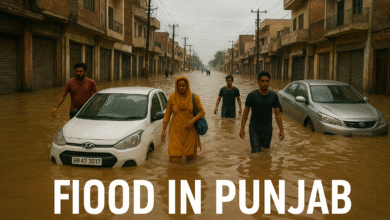Glacier Brust in Gilgit Baltistan: The Story of Ghizer Lake and Nature’s Wrath

Glacier Brust in Gilgit Baltistan has given birth to lakes like Ghizer Lake, Attabad, and Khalti. These natural disasters reshape lives, displace families, and highlight the urgent need for climate action and early warning systems.
Mountains That Create and Destroy
The mountains of Gilgit Baltistan are famous for their breathtaking beauty, but they also carry stories of destruction. From Talidas in Ghizer to Attabad in Hunza, and from Khalti to Badswat and Ishkoman, nature has repeatedly reminded people of its power. Glacier bursts and landslides have blocked rivers, created new lakes, and forced communities to leave their homes behind.
Recently, in Talidas village of Ghizer district, a glacier lake outburst flood (GLOF) struck, filling the river with rocks and debris. The water soon formed a massive 7 to 8 km long Ghizer Lake, submerging houses and displacing hundreds of residents. At first glance, the lake looks calm and picturesque, but it was born out of chaos and destruction.
Lessons from the Past
This tragedy is not unique. Gilgit Baltistan has faced similar events before:
-
1999 – Khalti Lake: A glacier burst near Khalti triggered floods, blocked the Ghizer River, and formed Khalti Lake.
-
2010 – Attabad Lake, Hunza: A landslide destroyed half of Attabad village, blocked the Hunza River, and created what is now one of the most famous lakes in Pakistan.
-
2022 – Badswat, Yasin Valley: A GLOF swallowed an entire village, leaving more than 40 families homeless.
-
2025 – Chattorkand, Ishkoman Valley: Floods once again blocked the river, forming another lake and displacing communities.
Each event shows how fragile life in the mountains is. What tourists see as natural wonders are, in fact, monuments of loss for the locals.
The Role of Climate Change
Experts believe these disasters are linked to climate change. Rising global temperatures are speeding up glacier melting, which increases the chances of floods and landslides. Gilgit Baltistan is home to more than 7,000 glaciers, making it one of the most sensitive regions in the world.
If the pace of warming continues, more glacier brusts in Gilgit Baltistan are expected. These events not only endanger lives but also threaten fertile lands, livestock, infrastructure, and even hydropower projects that Pakistan relies on.
The Human Face of Disaster
Behind the beauty of lakes like Ghizer, Attabad, or Khalti lies human suffering. Families lose their homes, farmers watch their crops drown, and children are forced to abandon schools. For those living in the mountains, survival was already tough due to harsh weather and limited resources. Now, with disasters striking more frequently, their struggle has only deepened.
While outsiders admire these lakes for tourism, locals see them as reminders of tragedy.
Can We Prevent Such Events?
Scientists agree that natural processes cannot be fully stopped. Landslides, floods, and glacier outbursts are part of the mountain ecosystem. However, preparedness and early warning systems can make a huge difference.
Steps that can help include:
-
Installing community-based early warning systems in vulnerable valleys.
-
Building stronger roads, bridges, and shelters in flood-prone areas.
-
Relocating communities living directly in danger zones.
-
Training locals in emergency evacuation and relief response.
Such measures may not stop a glacier from bursting, but they can save hundreds of lives and reduce damage to property.
Disasters like the creation of Ghizer Lake are also a wake-up call for everyone, not just the people of Gilgit Baltistan. Climate change is a global problem, and reducing its impact requires collective effort.
Here’s what can be done:
-
Reduce carbon emissions by using clean energy and limiting vehicle pollution.
-
Encourage eco-tourism so that visitors enjoy the natural beauty while respecting local culture and environment.
-
Promote afforestation to stabilize the soil and reduce landslides.
-
Adopt sustainable lifestyles by cutting waste, conserving water, and supporting green policies.
If we take responsibility now, we can preserve Gilgit Baltistan’s beauty for future generations. Otherwise, many more valleys could turn into lakes born from disaster.
Every glacier brust in Gilgit Baltistan tells a story of resilience but also of warning. The newly formed Ghizer Lake is not just another tourist attraction. it is a reminder that nature is changing faster than we are adapting. These events cannot be reversed, but their impact can be reduced.
The people of Gilgit Baltistan deserve more than survival; they deserve security and a future where their lands are safe. Protecting this region is not only about saving lives, it is about preserving some of the most breathtaking landscapes on Earth.
The question is: Will we act in time, or will we wait for the next lake to remind us of our negligence?
